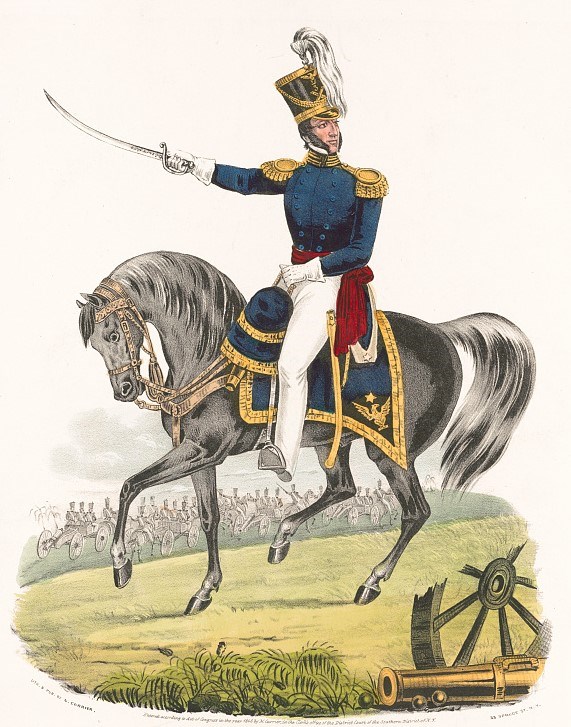Last updated: October 30, 2019
Article
Of Mythical Importance
True or False?
Columbus thought the world was flat. The Pilgrims first set foot in America on Plymouth Rock. George Washington never told a lie. Abraham Lincoln hastily wrote the Gettysburg Address on the back of an envelope.
Truth, Myth...a Little of Both?
Many of the people, places, and events of U.S. history have become the subject of popular and familiar legends. Some of these tales hold a grain of truth and some none at all. Palo Alto Battlefield generates many interesting stories as well. Most of the tales linked to the site are true. Some are partly true. Others are myths and unfounded rumors. Have you been misinformed?

Instituto Nacional de Estadística y Geografía (INEGI)/public domain
Texas: A Whole Other Country?
The Claim
The Republic of Texas joined the United States through a treaty between two equal Republics. This means Texas can leave the Union whenever it wishes.
The Story
President John Tyler the administration of Sam Houston did sign an annexation treaty in April 1844. However, the U.S. Senate rejected the document, leaving annexation in question.
When James K. Polk won the presidency later that year, Texas reemerged as an issue. Polk had run for office with a promise to annex Texas. Upon Polk’s election, President Tyler called for the Congress to vote on his Tyler-Texas treaty by simple majorities in each house. The bill passed both houses, narrowly in the Senate. Outgoing President Tyler signed the bill on March 1, 1845 and forwarded the House version to Texas on March 3, 1845.
Texas President Anson Jones called for a convention on July 4, 1845. At the convention’s conclusion, the annexation offer was unanimously approved. Texas officials then began the well- established procedure for bringing new territories into the Union. They developed a state Constitution and submitted it to the U.S. Congress for approval.
A State Is Born
On December 29, 1845, President James K. Polk signed the Joint Resolution for the admission of the state of Texas. On that day, the government of the Republic of Texas was formally dissolved and the State of Texas emerged. Texas did not enter the United States as one of two equal republics but as one of 28 equal states.
The Civil War reinforced this bond. Texas left the Union in 1861 and was one of the last Confederate states to rejoin the fold. By retaking its place in the United States, Texas once again accepted the rule of the federal Constitution.
One of the Fold
A Presidential proclamation on August 20, 1866 welcomed Texas' return, but firmly stated, "...no state, of its own will, has a right or power to go out of or separate itself from, or be separated from the American Union…”

Public domain
Flag Like No Other?
The Claim
The Texas flag is the only state flag allowed to fly side-by-side with the U.S. flag. All other state flags must fly below the Stars and Stripes.
The Story
The belief the Texas flag has some unique status is often linked to the idea Texas joined the U.S. in a special way. Others claim Texas is different simply because it is the only state that was once an independent nation. Neither is true.
Texas surrendered special rights when it joined the Union. Texas is also not so unique for operating as a separate nation. Vermont was independent from 1777 to 1791. California was home of the short-lived "Bear Flag Republic". Portions of Florida included in the 1810 Republic of West Florida. Hawaii was also once an independent kingdom. All can claim periods of independence. Like Texas, none have special flag rights.
The Code
Texas state flag can fly on an equal level with the United States flag. However, the same rule applies to all other state flags.
The U.S. flag code states the U.S. flag should always be higher if flown on the same pole with a state flag. If a state flag and the national flag are flown on separate poles, the code simply states no other flag be flown higher than the U.S. flag.
Nonetheless, the national flag and state flags don’t share equal status. The Stars and Stripes is always flies on the right when displayed alongside a state flag. The U.S. flag code also states the national flag is raised first and lowered last when displayed with other flags.

Library of Congress/No known restrictions
Samuel Ringgold: The First to Fall
The Claim
Major Samuel Ringgold was the first U.S. officer to die in the war with Mexico.
The Story
Following the battle of Palo Alto, Ringgold became a national hero. His countrymen celebrated his efforts to develop the "flying artillery" that performed so well during the battle. They also mourned his death from wounds received in the fight.
Numerous prints and paintings showed him receiving his fatal wound. Poems and songs praised his bravery. Citizens even named towns, streets, and parks for the first officer to die on the battlefield. But he wasn't the first and he didn't die on the field.
Mexican cannon fire mortally wounded Ringgold during the battle of Palo Alto on May 8th but did not die that day. Ringgold lost both of his legs to amputation. Afterwards, Ringgold was taken to a hospital at Point Isabel. There, he died to his wounds on May 11th. However, several other officers died before this date.
The First Casualties
Some officers fell before the formal declaration of war. Colonel Truman Cross and Lieutenant Theodore Porter died in April 1846, in separate attacks by bands of Mexican guerrillas. Lieutenant George T. Mason fell in combat on April 25th at Rancho de Carricitos. The skirmish prompted a formal war declaration but occurred before the formal conflict.
Lieutenant Jacob Blake died on the field at Palo Alto on May 9th but not from battle wounds. He shot himself with his own gun in a freak accident the morning after battle.
Major Jacob Brown was the first officer to die from combat after the war declaration. Brown was the commander of the U.S. fort on the Rio Grande. On May 6th Mexican cannon fire mortally wounded Brown. He died from his wounds on May 9th—two days before Ringgold.
Brown received recognition for his sacrifice, most notably as the namesake of Fort Brown and the city of Brownsville, Texas. Ringgold, however, remains widely known as the "first killed." in the war.

Library of Congress/No known restrictions
Appomattox: A Reunion of Friends
The Claim
Ulysses S. Grant and Robert E. Lee fought side by side in the Mexican War before leading opposing armies in the U.S. Civil War. The two old friends discussed their shared experiences in the Mexican War just before signing their famous peace treaty at Appomattox Courthouse in 1865.
The Story
Numerous veterans of the war with Mexico fought in the Civil War, some for the Union and some for the Confederacy. Often, men who had been friends in the first war were force to confront each other in the later conflict.
Lee and Grant both fought in the war with Mexico, but they were not close friends. Grant, a Lieutenant in the infantry, and Lee, a Captain in Corps of Engineers, apparently only crossed paths once during the war.
A Brief Encounter
The two men did speak briefly about the Mexican War before settling down to business at Appomattox. In an attempt to lighten the mood, Grant mentioned their brief encounter. General Lee reportedly replied, "Yes, I know I met you on that occasion, and I have often thought of it and tried to recollect how you looked, but I have never been able to recall a single feature." After a few more words, the two moved on to discuss terms of surrender.
A better example of a meeting of former brothers-in-arms occurred between Grant and Confederate General John Pemberton. Before Pemberton surrendered the besieged city of Vicksburg to Grant on July 4, 1863, the two old friends sat down together under a tree. The veterans of the Battle of Palo Alto sat and reminisced about the time when they fought in the same army and for the same cause.

PublicDomainArchive/Pixabay
A Golden Secret
The Claim
General Mariano Arista buried a payroll box fill with gold somewhere near Palo Alto on May 8, 1846. He was preparing to pay his troops when the U.S. Army arrived at the scene. As he rushed to confront the enemy, Arista ordered paymasters to bury the box of pesos for recovery after the battle.
The clash went poorly for Arista and he withdrew before he disinterred the gold. Following the disastrous loss at Resaca de la Palma, the Mexican army retreated and was unable to retrieve the money.
The Story
Supporters of this myth offer a variety of endings to the tale. Some report those who buried the gold returned years later to claim it. Others insist it remains in the ground. Treasure hunters have searched for the gold in the 150 years since the battle.
Stories abound of ghostly fires that flare up in near where the pay box lies. There have even been suggestions a modern treasure hunter found the box and disappeared with its riches.
Did the Box Exist?
Almost certainly not. Arista had very little money to buy food and even less to pay the troops. In the months leading up to the battle, the Mexican army made its payments in the form of worthless paper or IOUs. Since the Mexican government was bankrupt and its treasury empty, Arista never received a large quantity of gold to disburse to the troops.
There was also no reason to haul payroll across the river. The troops had nowhere to spend the money and, as they prepared for battle. They would have been far happier with a small increase in their rations than a whole chest of gold.
